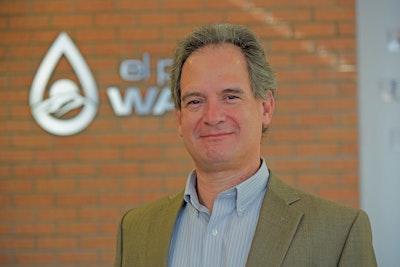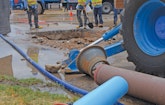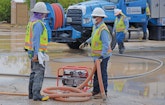
El Paso Water lead service worker Robert Almanza moves traffic control cones while gravel is brought in to backfill a trench at the site of a water main repair. (Photography by Brian Kanof)
Interested in Infrastructure?
Get Infrastructure articles, news and videos right in your inbox! Sign up now.
Infrastructure + Get AlertsFor years, El Paso Water in Texas struggled with odor control at its John T. Hickerson Water Reclamation Facility. The plant’s location in a low-lying area alongside a busy interstate and near residences and businesses meant increased scrutiny for that odor, and complaints were common.
But after installing a super oxygenation system at the primary lift station that feeds the plant, those odor complaints have been eliminated for the most part.
“About the only time we get odor complaints now is when there’s some sort of an equipment malfunction — a pump goes out on the super oxygenation system or the odor control tower at the plant is under maintenance,” says David Ornelas, El Paso Water’s wastewater systems division manager, who has been with the utility for 21 years. “Our normal operation now is without any odor complaints. They used to come in pretty consistently, even from people just driving by the plant.”
Since the super oxygenation system went online in January 2015, El Paso Water has become one of the top case studies for the technology’s benefits because of how well it has worked for the utility. El Paso Water most recently showcased it at the Water Environment Federation’s Collections System Digital Conference in June, where it did a virtual tour of the Hickerson plant and the nearby lift station that contains the super oxygenation system.
“This technology has been a really good match,” Ornelas says.
Searching for a solution
El Paso Water serves a population of about 800,000, encompassing the city of El Paso and several surrounding areas. On the wastewater side, that involves operating and maintaining 2,300 miles of sewer lines, 75 lift stations and four treatment plants.
But in 2012, the utility focused some extra attention on the Hickerson plant. “We decided we needed to do an in-depth odor assessment of the plant, so we hired an engineering firm and started looking at possible solutions,” Ornelas says.
The Hickerson plant does not have any primary clarifiers. Wastewater goes straight into the aeration basins after going through the screening process. Ornelas says odor issues were focused around the headworks and the plant’s dewatering building. The utility hired JACOBS to begin looking at options for both vapor phase treatment and liquid phase treatment.
“For liquid phase treatment, they were looking at going upstream to a lift station that pumps about 90% of the wastewater that goes into the plant,” Ornelas says.
The Frontera Lift Station sits about 3 1/2 miles upstream of the Hickerson plant, pumping a significant majority of the plant’s 11 mgd flow through dual force mains that get as large as 42 inches in diameter by the time they reach the plant. JACOBS discovered high levels of sulfides in the wastewater at the lift station.
“We had a small oxygen system at the lift station at that time,” Ornelas says. “We injected oxygen using a plain, simple diffuser system. But that wasn’t doing much due to the high levels of dissolved sulfides.”
While JACOBS looked at possible options for liquid phase treatment at the lift station, Ornelas and his team also did some research.
“We discovered this super oxygenation system. We saw some case studies in California and other areas, but we had never seen it around here,” Ornelas says.
El Paso Water asked JACOBS to look into it. The designer of the system, Indianapolis-based ECO Oxygen Technologies, considered El Paso’s particular factors — sulfide levels, pipe length and detention time — and confirmed that its ECO2 SuperOxygenation System would be a good fit.
“It had the lowest life-cycle costs of all the liquid phase treatment options that were out there,” Ornelas says.
How it works
The ECO2 system works by pumping a sidestream of the wastewater entering the lift station into its Speece Cone — a conical-shaped oxygen transfer device. Oxygen is metered into the cone and completely dissolved due to the large gas/wastewater interface generated by the bubble swarm inside the cone. The oxygenated wastewater is then blended back into the lift station’s flow discharge.
“The technology relies on adding a sufficient amount of oxygen to overcome the amount of dissolved sulfides and other compounds that consume oxygen in the wastewater,” Ornelas says. “So based on the amount of dissolved sulfides in the wastewater and the amount of flow at the lift station, they were able to size a super oxygenation system that was appropriate. You have this degradation of the dissolved oxygen in the force main as it goes to the plant, but they were able to size it so that we would maintain at least 0.5 mg/L of dissolved oxygen when the flow reached the plant.”
Out of the roughly 10 mgd coming through the Frontera Lift Station, only 4,500 gpm is diverted into the sidestream that goes into the super oxygenation system. But the level of oxygen saturation that occurs in the system’s Speece Cone is so high that it greatly reduces the sulfide levels in the wastewater traveling from the lift station to the Hickerson plant. And since the lift station represents nearly all of the flow that the plant receives on a daily basis, it reduces the odor that El Paso Water had been aiming to address.
“That Speece Cone has a high transfer of the oxygen into the wastewater, which is what we weren’t able to do before with the regular diffusing system,” Ornelas says. “The transfer efficiency of the oxygen is so great that you’re able to add significant amounts of dissolved oxygen and maintain it in the force main all the way to the plant.”
In addition to getting the odor under control, another benefit has been the reduction in corrosion in the 3 1/2 miles of force main between the Frontera Lift Station and Hickerson plant.
“The corrosion reduction is important,” Ornelas says. “Replacing those force mains would be a high capital cost, so anything we can do to maintain and reduce corrosion is significant.”
A cost-effective fix
In total, the project cost El Paso Water nearly $1.1 million, split almost evenly between ECO Oxygen Technologies for the equipment and a contractor for the installation.
Installation went well, Ornelas says, but the logistics of it were challenging enough that it was imperative to have a good contractor. The Speece Cone sits 24 feet above the force mains, so piping had to be routed to ground level and then back to the force mains. And the lift station had to remain fully operational during installation, so the hot tapping that was required presented another challenge. El Paso Water was able to take advantage of the oxygen system that had already been on site.
“We have a vendor who supplies everything — the tank, the evaporators — so we used the system that was already there and just had to run the oxygen line to the Speece Cone,” Ornelas says.
The investment in the super oxygenation system has been well worth it, Ornelas says. Prior to its installation, the Hickerson plant relied on vapor phase treatment for odor control, using chemical scrubbers at the headworks and the dewatering building. The super oxygenation system has reduced the amount of chemicals needed for those scrubbers. And it has meant that the utility hasn’t had to worry about constructing additional air treatment systems at the plant, which was really the only other avenue left for improving odor control.
“Fortunately, this super oxygenation option was there, and it’s worked out well,” he says. “Not only did it reduce odors at the plant, but it also reduces odor and corrosion along the route of the force mains. The cost of installing the system is much better compared to the cost of having to replace force mains or install more air treatment systems at the plant.
“It was definitely a team effort,” he adds of the project, citing other valuable members of the utility like Aide Fuentes, wastewater treatment manager, who served as project manager during the system’s installation.
Assessing other sites
The successful application at the Hickerson plant has El Paso Water looking at other areas of its system that could benefit from the super oxygenation technology.
The one that sticks out at the moment, Ornelas says, is the Fred Hervey Water Reclamation Plant because of its similarities to the Hickerson plant. It too receives a significant amount of its flow from a single lift station, but unlike the Hickerson plant, it is in a more remote location so odor complaints have not been a chronic issue.
“It’s not as big of an issue as the Hickerson plant, but we’re looking at it both for odor control and corrosion control,” Ornelas says. “That’s the other major benefit of this is the corrosion control, so we’re looking at other super oxygenation systems to see if they’re a good fit.”










